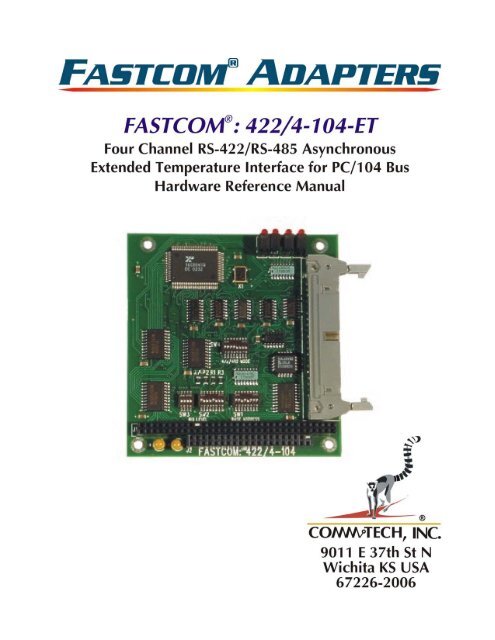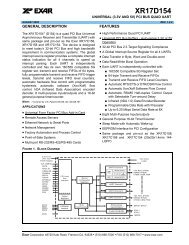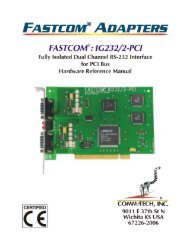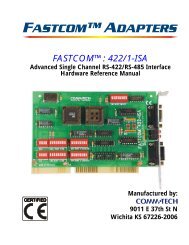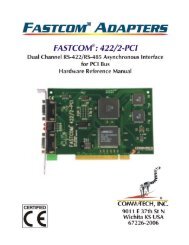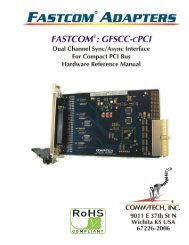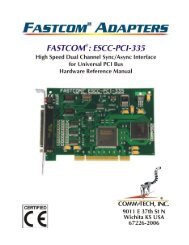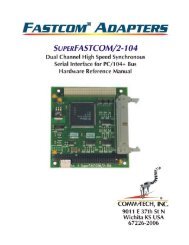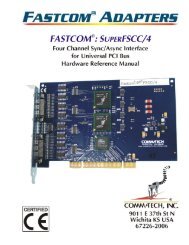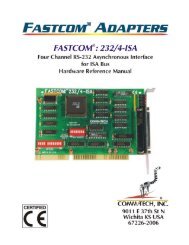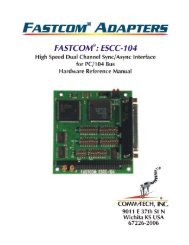FASTCOM®: 422/4-104-ET HARDWARE MANUAL - Commtech ...
FASTCOM®: 422/4-104-ET HARDWARE MANUAL - Commtech ...
FASTCOM®: 422/4-104-ET HARDWARE MANUAL - Commtech ...
You also want an ePaper? Increase the reach of your titles
YUMPU automatically turns print PDFs into web optimized ePapers that Google loves.
1INTRODUCTIONThe new FASTCOM: <strong>422</strong>/4-<strong>104</strong>-<strong>ET</strong> adapter is the fastest (1.5 Mbps), most advanced, four-port RS-<strong>422</strong>asynchronous adapter in the industry. Primarily designed for commercial, industrial, and OEM applications, theFASTCOM: <strong>422</strong>/4-<strong>104</strong>-<strong>ET</strong> features four discrete RS-<strong>422</strong> channels, complete with RTS and CTS flow controlsignals, and is specified to operate in the extended temperature range.The advanced UART on the FASTCOM: <strong>422</strong>/4-<strong>104</strong>-<strong>ET</strong> features full compatibility with standard 16C550 and16C650 UARTs, but provides extraordinary 128-byte receive and transmit FIFOs for buffering. This bufferingis extremely important when working with RS-<strong>422</strong>/RS-485 communications within high overhead operatingsystems such as Windows NT and Windows 95/98. The extra-deep FIFOs prevent data loss due to overrun anddramatically improve data throughput in all applications. The advanced UART on the FASTCOM: <strong>422</strong>/4-<strong>104</strong>-<strong>ET</strong>is capable of all standard baud rates plus a high-speed mode capable of up to an amazing 1.5 Mbps(crystal change required).The Fastcom CD contains software and information for DOS, Linux, Windows 95/98, Windows NT, and Windows2000, and is compatible with Windows XP. The "shared interrupt" design and user selectable address allow theinstallation of multiple FASTCOM: <strong>422</strong>/4-<strong>104</strong>-<strong>ET</strong> cards in the same system.The FASTCOM: <strong>422</strong> family of adapters includes the dual channel FASTCOM: <strong>422</strong>/2-<strong>104</strong>, the single channelFASTCOM: <strong>422</strong>/1-ISA and the dual channel FASTCOM: <strong>422</strong>/2-ISA for the ISA bus, and the fully isolatedFASTCOM: IG<strong>422</strong>/1-ISA. The FASTCOM: <strong>422</strong>/2-PCI, the FASTCOM: <strong>422</strong>/4-PCI, and the FASTCOM: IG<strong>422</strong>/1-PCI are available for PCI bus systems.The following is the basic structure of the FASTCOM: <strong>422</strong>/4-<strong>104</strong>-<strong>ET</strong>:PC/<strong>104</strong>BUSA12|A5A0-A2D7|D0IRQ 15|IRQ 2CHANNELSELECTDATABUFFERINTERRUPTSHARINGLOGIC38SWITCH 1CHANNEL 1 (OF 4)CSA0-A2UART128 BYTEFIFO BUFFERDATAINTERRUPT8MODESELECTSWITCH 4RS-<strong>422</strong>/RS-485DRIVERS/RECEIVERSSTATUS LEDsTXRXDB 37TX+TX-RX+RX-RTS+RTS-CTS+CTS-
2SPECIFICATIONS:UART:16C864BAUD RANGE: Up to 1.5 Mbaud *BUFFERING:INTERFACE:SIGNALS:PROTOCOL:BUS:Transmit - 128 bytesReceive - 128 bytesRS-<strong>422</strong>/RS-485C40 pin latch lock pin headerTX, RX, RTS, CTSAsynchronousPC/<strong>104</strong>POWER REQUIREMENTS: +5 500mA (typical)ENVIRONMENT:Storage Temperature Range:Operating Temperature Range:Humidity:-55 C to +125 C-40 C to +85 C0 to 90% (non-condensing)FEATURES:Fastcom: <strong>422</strong>/4-<strong>104</strong>-<strong>ET</strong>Four independent RS-<strong>422</strong> / RS-485 channelsTransmit / Receive status LEDs for each channelTX, RX, RTS, CTS signals for each channelExcellent noise immunityExtended temperature componentsDesigned for operation in more extreme environmentsAddress modeWINDOWS MODE: Ports are configured as COM1, COM2, COM3, and COM4FASTCOM MODE: Ports are assigned address and IRQ by the userRS-485Up to 32 stations on same “twisted-pair” networkRTS control of the line driverHigh performance 16C864 UARTStandard on the Fastcom: <strong>422</strong>/4-<strong>104</strong>-<strong>ET</strong>, no extra chargeHigh throughput, full compatibility, higher speedDocumentation, software, and drivers included on CDMade in Wichita, Kansas, USA* A clock change is required to achieve baud rates higher than 115.2 Kbaud.
3FASTCOM: <strong>422</strong>/4-<strong>104</strong>-<strong>ET</strong>BOARD LAYOUT ILLUSTRATION16C864UARTTRANSMIT/RECEIVESTATUSLEDsMODESWITCH40 PIN LATCH-LOCKCONNECTORIRQ SELECTSWITCHESBASE ADDRESSSWITCHPC/<strong>104</strong> CONNECTORSON BACKOF BOARDTERMINATION REFERENCE:LED INDICATORS:REFSIGNALR12 RX 1 RED - TRANSMIT ACTIVER11 RX 2 YELLOW - RECEIVE ACTIVER10 RX 3R9 RX 4R8 CTS 1R7 CTS 2R6 CTS 3R5 CTS 4PACKING LISTFASTCOM: <strong>422</strong>/4-<strong>104</strong>-<strong>ET</strong> CARDCABLE ASSEMBLYFASTCOM CDIf an omission has been made, please call technical support for a replacement.
4INSTALLATIONImportant: Observe Electrostatic Discharge (ESD) precautions when handling the FASTCOM: <strong>422</strong>/4-<strong>104</strong>-<strong>ET</strong> board.FACTORY SWITCH S<strong>ET</strong>TINGSNOTE: See the Board Layout Illustration for the location of switches on the board.ONADDRESS (SW1) = 280H1 2 3 4 5 6 7 8ONONIRQ (SW3 SW2) = 5 (NOT SHARED)1 2 3 41 2 3 4 5 6 7 8ONMODE (SW4) - CTS HANDSHAKING DISABLEDMODE (SW4) - RS-485 DRIVER CONTROL DISABLED1 2 3 4 5 6 7 8INSTALLING THE FASTCOM: <strong>422</strong>/4-<strong>104</strong>-<strong>ET</strong> IN THE PC/<strong>104</strong> STACK1. Unpack the FASTCOM: <strong>422</strong>/4-<strong>104</strong>-<strong>ET</strong>. Keep the box and static bag for warranty repair returns.2. Check the switches to be sure that they are set for the mode you want.3. Re-install the cover on your PC/<strong>104</strong> stack.
5TESTING THE INSTALLATIONTo fully test the installation of your FASTCOM: <strong>422</strong>/4-<strong>104</strong>-<strong>ET</strong>, you will need to build a “loop back plug”. Materialsneeded are a DB9 male plug, solder cup style, and a few short pieces of 20 or 24 AWG stranded wire. Jumperthe pins together on the DB9 as illustrated below:4 TX+5 TX-8 RX+9 RX-4589TESTING YOUR FASTCOM ASYNC PC/<strong>104</strong> PORT IN WINDOWSThese instructions assume that you have already installed the card and have followed the installation instructions.In NT, the ports should be visible in the Control Panel ->Ports applet. In Windows 98, the ports should show up inControl Panel in the System icon’s Device Manager. The port installation instructions can be found on the disk in:For Windows98 D:\Fastcom_Disks\Smart14\Windows\W98\howto.txtFor Windows NT D:\Fastcom_Disks\Smart14\Windows\NT\howto.txtFor Windows 2000/XP D:\Fastcom_disks\Smart14\WINDOWS\W2000\W2kserialInstall.txtFor LinuxD:\Fastcom_disks\Smart14\howto.txt1. Install the loopback plug on the port to test.2. Find and run the TTY.EXE program.From the Start menu, choose Run, browse to and selectD:\Fastcom_Disks\Smart14\windows\win32\tty\tty.exe.Select TTY.EXE and click open.Click OK to run the TTY program.3. From the menu bar on the TTY program, select Settings.Select the port to test (e.g., COM5)Uncheck all of the flow checkboxes (DTR/DSR, RTS/CTS, XON/XOFF).Click OK.4. From the TTY main menu bar select Action, then Connect.5. At this point you should see a blinking cursor in the upper left corner of the TTY window. Try to type on thekeyboard; you should see the characters that you are typing in the TTY window. If you see what you type, theport is passing the loopback, and is installed and functioning correctly.If you get a “Connection Failed” message box when you try the Action ->Connect sequence, some possiblecauses are:1. Incorrect or mismatched address or IRQ settings between what the switches on the board are set to andwhat is set up in the driver. You can check the driver settings in NT using Control Panel ->Ports ->COMx->Advanced. In Windows 98, you need to look in Control Panel ->System, Device Manager tab, Ports(COM & LPT), select the COM#, click the Properties button, then the Resources tab. Check the addressswitch settings using the table in the back of the manual. Realize that multiport cards addresses are
6sequential (if set to base address of 0x280, then the addresses for the four ports will be 0x280, 0x288,0x290, and 0x298).If you are using NT, you can run NT Diagnostics (from the Start button, choose Programs ->Administrative Tools ->Windows NT Diagnostics) to verify that there is not another device trying to usethe address range or IRQ. The Resources tab in Windows 95 (location listed above) should indicate aresource conflict if another device is using the same I/O range or IRQ. Even if you don’t see a listedconflict, try a different address/IRQ combination if all of the settings are matched and it still doesn’t work.If you have tried a couple of different address/IRQ combinations without success, you might try using anOhm meter or continuity tester to verify that the switch positions are actually what they are set to. Theswitch positions that are ON should be closed (about 0 ohms); the ones that are OFF should be open (not0 Ohms). Sometimes the dip switches will get stuck in either the on or off position irrespective of theposition of the slide. If this happens, try toggling the stuck position on and off a few times and re-check it.2. In NT, if multiple ports are opened (running more than one instance of TTY), the ports are using the sameIRQ, and the PermitShare registry entry is 0, the second port to be opened will fail. Use the registryeditor and expand HKEY_LOCAL_MACHINE ->SYSTEM ->CurrentControlSet ->Services ->Serial,change the PermitShare value from 0 to 1, reboot, and run the test again.If you get to the blinking cursor stage, but do not see what you type with the loopback plug installed, somepossible reasons are:1. Incorrect/faulty loopback plug construction or a bad connection.2. If you have a RS-<strong>422</strong>/485 board, check to make sure that the 485 mode is disabled. The loopback testshould be run in RS-<strong>422</strong> mode (the RS-485 driver control switches should be in the OFF position).3. The RTS/CTS flow control is checked and there is not a RTS->CTS loopback, or the CTS disabled switchis OFF. If you enable flow control, you must allow CTS to be active in order for the driver to transmit data.Either disable flow control, or wire the RTS->CTS (and possibly DTR->DSR) loop and try the test again.4. Check to make sure that the loopback plug is on the correct port/cable (or that the correct port is selectedin the settings dialog).5. If you type a character and the cursor stops blinking for a long time and the PC/TTY window stopsresponding (appears locked up) but returns to a blinking cursor state after a few minutes, this is a goodindication that the interrupt setting on the card is not the same as the interrupt setting of the port inWindows. Re-verify that the IRQ setting on the board switches and in Control Panel are the same.
7FASTCOM: <strong>422</strong>/4-<strong>104</strong>-<strong>ET</strong> OPERATING MODESThe FASTCOM: <strong>422</strong>/4-<strong>104</strong>-<strong>ET</strong> has two modes of operation: the FASTCOM MODE and the WINDOWS MODE.The operating mode is selected by the setting of position 6 of switch 2. In the ON position, the WINDOWS MODEis selected. In the OFF position, the FASTCOM MODE is selected. In the FASTCOM MODE, the boardaddress/IRQ configuration is determined by setting Switches 1, 2, and 3. In the WINDOWS MODE, each channelis assigned an address/IRQ level that provides "drop-in" compatibility with WINDOWS/DOS applications.WINDOWS MODEIf the WINDOWS MODE is selected, the base address switch (Switch 1) is overridden. Switch 2, Position 6should be set to ON, and all other positions should be set to OFF. All positions on Switch 3 should be set to OFF.The Address/IRQ for each channel is as follows in WINDOWS MODE:CHANNEL ADDRESS IRQ NAMECHANNEL 1 3F8H 4 COM1:CHANNEL 2 2F8H 3 COM2:CHANNEL 3 3E8H 4 COM3:CHANNEL 4 2E8H 3 COM4:IMPORTANT: Be sure that Switch 2, Position 6 is ON and all other positions on Switches 2 and 3 are OFF.FASTCOM MODE SWITCH DESCRIPTIONSThere are four dip switches on the FASTCOM: <strong>422</strong>/4-<strong>104</strong>-<strong>ET</strong> labeled SW1, SW2, SW3, and SW4 (See BoardLayout Illustration for location). Switch 1 (labeled Base Address) is used to set the I/O address of the FASTCOM:<strong>422</strong>/4-<strong>104</strong>-<strong>ET</strong> board. Switch 2 (labeled IRQ) serves three functions: it selects the IRQ level for the board, is usedto enable/disable interrupt sharing, and selects the operating mode for the board. Switch 3 is used to selectupper level IRQ settings. Switch 4 is used to control the RS-<strong>422</strong>/485 operating modes.
8SWITCH DESCRIPTIONSThere are four dip switches on the FASTCOM: <strong>422</strong>/4-<strong>104</strong>-<strong>ET</strong>, labeled SW1 through SW4 (See Board LayoutIllustration for location). Switch 1 (labeled BASE ADDRESS) is used to set the base I/O address of theFASTCOM: <strong>422</strong>/4-<strong>104</strong>-<strong>ET</strong> board. Switches 2 and 3 (labeled IRQ SELECT) serve two functions: they select theIRQ level and are used to enable/disable interrupt sharing. Switch 4 (labeled MODE SWITCH) selects either RS-<strong>422</strong> or RS-485 mode and enables/disables handshaking for each channel.SWITCH 1, BASE ADDRESSSwitch 1 decodes the PC/<strong>104</strong> address lines as follows:ON1 2 3 4 5 6 7 8 Address Line Hex valueA10 400A9 200A8 100A7 80A6 40A5 20A4 10A3 8Address lines A5 through A12 are decoded by the setting of SW1and set the address of each channel of the FASTCOM: <strong>422</strong>/4-<strong>104</strong>-<strong>ET</strong>. Address lines A3 and A4 are used on the board to selectwhich port (1, 2, 3, or 4) you want to use. Address lines A0, A1,and A2 are used to select the registers within the UARTs.The above diagram illustrates a base address of 280 Hex. Notethat when a switch is ON it represents a “0” in the correspondingbit position (not a “1” as you might expect). Also, a switch that isOFF represents a “1” in the corresponding bit position. If youwould like to know why this is reversed, read a technical datasheet for the address decoder chip, a 74LS682.So, the SW1 diagram can be decoded as follows:A12 A11 A10 A9 A8 A7 A6 A50 0 0 1 0 1 0 0You can determine the base I/O address of the board by adding the Hex values for each address line that is set toa “1”. In the illustration, address lines A7 and A9 are set to “1”. So, add the hex value of A9 (200H) and A7(80H), and the result is the base I/O address (200H + 80H = 280H).Switch 1 is referred to as the Base Address switch because it marks the beginning address of the first channel onthe FASTCOM: <strong>422</strong>/4-<strong>104</strong>-<strong>ET</strong> board. The other channels are addressed as an offset to the first channel. Forexample, if we set the Base Address to 280H, note the address of each channel:CHANNEL BASE OFFS<strong>ET</strong> ADDRESS1 280H + 0H = 280H2 280H + 8H = 288H3 280H + 10H = 290H4 280H + 18H = 298HWe have provided a comprehensive guide to setting the address switch inAppendix A.Please note that not all of the I/O address space in a PC/<strong>104</strong> stack is available for your use. If you wish to selectan address other than the default, refer to Appendix A, I/O Address Usage Table, and select an address that doesnot conflict with devices installed in your PC/<strong>104</strong>. Keep in mind that the FASTCOM: <strong>422</strong>/4-<strong>104</strong>-<strong>ET</strong> requires 8contiguous bytes of address space per channel, for a total of 32 contiguous bytes.
9If you want to install more than one FASTCOM: <strong>422</strong>/4-<strong>104</strong>-<strong>ET</strong> board in your computer, be sure to set each to aunique I/O address. We recommend the following addresses for a multi-board system:FASTCOM: <strong>422</strong>/4-<strong>104</strong>-<strong>ET</strong> BOARD 1FASTCOM: <strong>422</strong>/4-<strong>104</strong>-<strong>ET</strong> BOARD 2FASTCOM: <strong>422</strong>/4-<strong>104</strong>-<strong>ET</strong> BOARD 3FASTCOM: <strong>422</strong>/4-<strong>104</strong>-<strong>ET</strong> BOARD 4BASE ADDRESS280H300H380H400HRemember that a single IRQ level can be shared between multiple FASTCOM: <strong>422</strong>/4-<strong>104</strong>-<strong>ET</strong> boards in a PC/<strong>104</strong>stack.SWITCHES 2 and 3, INTERRUPT SELECTSwitch 2 serves three functions: it selects the IRQ level for the FASTCOM: <strong>422</strong>/4-<strong>104</strong>-<strong>ET</strong>, enables/disablesinterrupt sharing, and selects the operating mode for the board. Switch 3 selects upper level IRQ settings.The following illustrates the IRQ select switches on the FASTCOM: <strong>422</strong>/4-<strong>104</strong>-<strong>ET</strong>:MODE SELECTONON1 2 3 4IRQ LEVELS1 2 3 4 5 6 7 8IRQBOARD 1SHARE IRQ LEVELSPositions 2 through 5 and 7 select the IRQ level for the FASTCOM: <strong>422</strong>/4-<strong>104</strong>-<strong>ET</strong>. Select only 1 IRQ level at atime. Position 6 selects either WINDOWS or FASTCOM mode.SWITCH 2 SWITCH 3SWITCH PC/AT/386 SWITCH IRQPOSITION IRQ Assigned POSITION LEVEL Assigned2 9 UNUSED 1 10 UNUSED3 3 COM2 2 11 UNUSED4 4 COM1 3 12 UNUSED5 5 UNUSED (LPT2) 4 15 UNUSED6 6 USED FOR DOS / WINDOWS MODE SELECT7 7 LPT1You can use any IRQ that is not assigned to a device installed in your PC/<strong>104</strong>.INTERRUPT SHARINGAn important feature of the FASTCOM: <strong>422</strong>/4-<strong>104</strong>-<strong>ET</strong> is its ability to share one IRQ with several other FASTCOMboards in the same computer. This is important because there are very few unassigned IRQs in the PC/<strong>104</strong>.
10Switch 2 positions 1 and 8 control the interrupt sharing circuit on the FASTCOM: <strong>422</strong>/4-<strong>104</strong>-<strong>ET</strong>. Position 1Enables interrupt sharing in the OFF position and Disables sharing in the ON position. Position 8 is called the“Board 1” switch. In the interrupt sharing mode, this switch must be ON for the first FASTCOM: <strong>422</strong>/4-<strong>104</strong>-<strong>ET</strong>board in your system, and OFF for all other FASTCOM: <strong>422</strong>/4-<strong>104</strong>-<strong>ET</strong> boards.SWITCH 2POSITION 1 8ON OFF Disables IRQ sharingOFF ON Enables IRQ sharing, first boardOFF OFF Enables IRQ sharing, second boardFor example, let’s assume that you want to set two FASTCOM: <strong>422</strong>/4-<strong>104</strong>-<strong>ET</strong> boards to share IRQ 5. SetSwitches 2 and 3 as follows for the first board:ONON1 2 3 4SW3SW21 2 3 4 5 6 7 8For the second board, set Switches 2 and 3 as follows:ONON1 2 3 4SW3SW21 2 3 4 5 6 7 8For any additional FASTCOM: <strong>422</strong>/4-<strong>104</strong>-<strong>ET</strong> board that shares IRQ 5, set Switches 2 and 3 the same as the firstboard.SWITCH 4, OPERATING MOD<strong>ET</strong>he FASTCOM: <strong>422</strong>/4-<strong>104</strong>-<strong>ET</strong> has two modes of operation selected by Switch 4: the RS-<strong>422</strong> mode and the RS-485 mode.ON1 2 3 4 5 6 7 8Channel 4 RS-485 driver controlChannel 3 RS-485 driver controlChannel 2 RS-485 driver controlChannel 1 RS-485 driver controlChannel 4 CTS handshakingChannel 3 CTS handshakingChannel 2 CTS handshakingChannel 1 CTS handshakingSwitch positions 1, 2, 3, and 4 enable or disable CTS handshaking for each channel. When ON, CTShandshaking is disabled; when OFF, CTS handshaking is enabled. In RS-485 mode, CTS handshaking is usuallydisabled.
Switch positions 5, 6, 7, and 8 enable or disable RS-485 driver control for each channel. When ON, the transmitdriver enable line is controlled by the state of the RTS line of the UART. The RTS line may be controlled directlyby your software by writing to the UART Modem Control Register (See Appendix B). Setting the RTS bit to 1 inthe Modem Control Register will enable the drivers; setting it to 0 will disable the drivers.11
12RS-<strong>422</strong>/RS485Most engineers have worked with RS-232 devices at least once in their career. If you have never worked withRS-<strong>422</strong> or RS-485 devices, you will be pleased to know that working with the FASTCOM: <strong>422</strong>/4-<strong>104</strong>-<strong>ET</strong> is notmuch different from working with an RS-232 device.The RS-<strong>422</strong> standard was developed to correct some of the deficiencies of RS-232. In commercial and industrialapplications, RS-232 has some significant problems. First, the cable length between RS-232 devices must beshort (usually less than 50 feet at 9600 Baud). Second, many RS-232 errors are the result of cables picking upnormal industrial electrical noises, such as fluorescent lights, motors, transformers, and other EMF sources.Third, RS-232 data rates are functionally limited to 19.2K Baud. On the other hand, the newer RS-<strong>422</strong> standardmakes cable lengths up to 5000 feet possible and is highly immune to most industrial noises. Data rates are alsoimproved - the FASTCOM: <strong>422</strong>/4-<strong>104</strong>-<strong>ET</strong> features data rates up to 1 Meg Baud. These improvements weremade possible by differentially driving and receiving the data as opposed to the single ended method employedby the RS-232 standard. With the RS-<strong>422</strong> standard, the transmit signal (TX in RS-232) is a differential signalconsisting of TX+ and TX-, the receive signal (RX in RS-232) consists of RX+ and RX-.Another drawback of RS-232 is that more than two devices cannot share a single cable. This is also true ofRS-<strong>422</strong>, and that’s why the RS-485 standard was developed. RS-485 offers all of the benefits of RS-<strong>422</strong> andalso allows multiple units (up to 32) to share the same twisted pair. RS-485 is often referred to as a “multi-drop”or “two-wire, half duplex” network because the drivers (transmitters) and receivers share the same two lines. Infact, up to 32 stations can share the same “twisted pair”. In order for an RS-485 system to work, only one driver(transmitter) can occupy the network at a time. This means that each station on the network must control theenabling/disabling of its drivers in order to avoid network conflicts. If two drivers engage the network at the sametime, data from both will be corrupted. In RS-485 mode, the receivers are always enabled.For a more detailed description of RS-<strong>422</strong> and RS-485, we recommend the following references:LINEAR AND INTERFACE CIRCUITS APPLICATIONS, Volume 2: Line Circuits, Display Drivers. ByD.E. Pippenger and E. J. Tobaben. Published 1985 by Texas Instruments. ISBN-0-89512-185-9Note: This book may be difficult to find in a bookstore. The best place to get it is directly from TexasInstruments or from one their component dealers. Publication # SLYA002.“Driver/Receiver Family Extends Data-Link Performance”, ELECTRONIC PRODUCTS, January 15, 1985.By Dale Pippenger and Joe Miller.
13TERMINATION RESISTANCEIn both the RS-<strong>422</strong> and the RS-485 mode, the receiver end of the cable between two stations must be terminatedwith a resistor equal to the characteristic impedance of the wire. This is to prevent signal reflections in the wireand to improve noise rejection. However, you do not need to add a terminator resistor to your cables whenyou use the FASTCOM: <strong>422</strong>/4-<strong>104</strong>-<strong>ET</strong>. The termination resistance is built in. We have installed a terminatorresistor for each receiver: between each RX+ and RX-, and between CTS+ and CTS- for each channel.If you are using the FASTCOM: <strong>422</strong>/4-<strong>104</strong>-<strong>ET</strong> in a multi-drop network, the termination resistor should be removedfrom all units except the first and last (see the RS-485 illustration below). Call for technical support if you need tomodify the resistor.Observe the resistors in the following illustration and remember that they are built into the FASTCOM: <strong>422</strong>/4-<strong>104</strong>-<strong>ET</strong>:TERMINATION REFERENCE:REFSIGNALR12 RX 1R11 RX 2R10 RX 3R9 RX 4R8 CTS 1R7 CTS 2R6 CTS 3R5 CTS 4ON BACKOF BOARD
14DB9 PIN DESCRIPTIONThe FASTCOM: <strong>422</strong>/4-<strong>104</strong>-<strong>ET</strong> features four RS-<strong>422</strong>/RS-485 channels, which are accessed through DB9connectors connected to the board via ribbon cable.The following is a pin description of the DB9 connectors:PIN NO. SIGNAL NAME DIRECTION1 SIGNAL GROUND (GND) GROUND2 READY TO SEND + (RTS+) OUTPUT3 READY TO SEND – (RTS-) OUTPUT4 TRANSMIT DATA + (TX+) OUTPUT5 TRANSMIT DATA – (TX-) OUTPUT6 CLEAR TO SEND – (CTS-) INPUT7 CLEAR TO SEND + (CTS+) INPUT8 RECEIVE DATA + (RX+) INPUT9 RECEIVE DATA – (RX-) INPUTCABLERS-<strong>422</strong>We recommend using vinyl jacketed, shielded, multiple twisted pair cable (24 AWG wire) for use with theFASTCOM: <strong>422</strong>/4-<strong>104</strong>-<strong>ET</strong>. The following cable illustration shows how to connect two RS-<strong>422</strong> devices. Note thatthe CTS/RTS lines can be eliminated by disabling handshaking.TX+TX-RX+RX-GNDRTS+RTS-CTS+CTS-TX+TX-RX+RX-GNDRTS+RTS-CTS+CTS-Switch 4 settingON1 2 3 4 5 6 7 8Note: If you are not connecting the FASTCOM: <strong>422</strong>/4-<strong>104</strong>-<strong>ET</strong> to another FASTCOM: <strong>422</strong>/4-<strong>104</strong>-<strong>ET</strong>, you shouldmake sure that the line is terminated properly by the other device. Also note that other RS-<strong>422</strong> devices may notuse the same pin descriptions.
15RS-485The following cable illustration shows four RS-485 devices sharing the same twisted pair:Switch 4 setting:ONTX+TX-TX+TX+TX+TX- TX- TX-1 2 3 4 5 6 7 8RX+RX -RX+ RX + RX +RX - RX - RX -1 2 3 4Note: The termination resistors from Station #2 and Station #3 have been removed.Not all RS-<strong>422</strong> devices feature RS-485 compatibility. Only RS-485 devices can be connected to the RS-485network.
1640 PIN LATCH-LOCK CONNECTOR PIN-OUTLATCH3937353331292725POLARIZINGKEY2321191715131197531LATCH40383634323028262<strong>422</strong>2018161412108642CHANNEL 4CHANNEL 3CHANNEL 2CHANNEL 1PIN # SIGNAL NAME PIN # SIGNAL NAME1 GND 21 GND2 CTS- 22 CTS-3 RTS+ 23 RTS+4 CTS+ 24 CTS+5 RTS- 25 RTS-6 RXD+ 26 RXD+7 TXD+ 27 TXD+8 RXD- 28 RXD-9 TXD- 29 TXD-10 GND 30 GND11 GND 31 GND12 CTS- 32 CTS-13 RTS+ 33 RTS+14 CTS+ 34 CTS+15 RTS- 35 RTS-16 RXD+ 36 RXD+17 TXD+ 37 TXD+18 RXD- 38 RXD-19 TXD- 39 TXD-20 GND 40 GND
17TECHNICAL SUPPORT<strong>Commtech</strong> provides extensive technical support and application suggestions. Most of the problems that occur with theFASTCOM: <strong>422</strong>/4-<strong>104</strong>-<strong>ET</strong> can be corrected by double-checking the switch positions, your cables and your program. Werecommend that you build the loop back plug that is described in the Programming section of this manual. With that plug, youcan quickly isolate the problem to the board, cables, or software.If you still have unresolved questions, use the following procedure to get technical support:1. Call our Technical Support Staff at (316) 636-1131. They are on duty from 9:00 AM to 5:00 PM Central Time.2. Ask for technical support for the FASTCOM: <strong>422</strong>/4-<strong>104</strong>-<strong>ET</strong>. Be ready to describe the problem, your computer system,your application, and your software.3. If necessary, our staff will give you an RMA number (Return Material Authorization). Use this number on the mailinglabel and in all references to your board. Put the board back in its static bag and in its box. Ship the board back to usas directed.4. If you prefer, you may FAX a description of the problem to us at (316) 636-1163, or we can be reached on the Internetat http://www.commtech-fastcom.com/TechSupport.html or by email at techsupport@commtech-fastcom.com.FASTCOM LIMITED LIF<strong>ET</strong>IME WARRANTY<strong>Commtech</strong>’s entire FASTCOM product line is covered by a limited lifetime warranty against defects in workmanship. Thiswarranty is available only to the original purchaser and only covers defects in our workmanship. Any FASTCOM board that isreturned to <strong>Commtech</strong> will, at the option of <strong>Commtech</strong>, be repaired or replaced at no charge -- except for circumstancesexcluded by this warranty.A Return Materials Authorization (RMA) number must be obtained from <strong>Commtech</strong> before a return will be accepted. Pleasecontact us via telephone or email to obtain an RMA number.You are responsible for shipping charges when you return a FASTCOM board to <strong>Commtech</strong>. We will pay the shippingcharges to send the board back to you if a defect in workmanship is found. However, if no defect in workmanship is found, orthe board is not found to be defective, or the any of the following warranty exclusions occur, you will be responsible forshipping charges both ways.Warranty ExclusionsThis warranty does not cover problems or damage resulting from, but not limited to, the following:1. Any modification, misuse, abuse, disassembly, misapplication, or unauthorized repair by anyone other than<strong>Commtech</strong>.2. Any improper operation, including any use not in accordance with any verbal product instructions or documentation.3. Connection to an improper voltage supply or ESD damage.4. Any other cause not related to workmanship.Non-Warranty RepairsWe can provide a quote for non-warranty repairs upon request.If any <strong>Commtech</strong> product is damaged such that it cannot be repaired, you can return it to <strong>Commtech</strong> for replacement underour Non-Repairable Replacement policy, regardless of the cause of damage. <strong>Commtech</strong> will replace the unit at 60% of thethen-current list price.Limitation of Liability<strong>Commtech</strong> shall not be liable for any special, incidental, indirect, or consequential damages whatsoever, including but notlimited to loss of profits, revenue, or data (whether direct or indirect), or commercial loss for breach of any express or impliedwarranty on your product even if <strong>Commtech</strong> has been advised previously of the possibility of such damages. <strong>Commtech</strong> doesnot warrant that its products will work in every system or every system configuration. We do not warrant that our products willbe suitable for your application. If you are dissatisfied with our product, contact customer service to arrange for a return of ourproduct and refund of your money. <strong>Commtech</strong>’s liability, in any case, is limited to the original product purchase price and isavailable to the original customer only.
18APPENDIX AI/O ADDRESS S<strong>ET</strong>TINGSEach channel of the Fastcom: <strong>422</strong>/4-<strong>104</strong>-<strong>ET</strong> requires 8 contiguous bytes of address space for a total of 32contiguous bytes. The following are I/O addresses and devices that are typically assigned to them. You may useany I/O address that is not used by a device installed in your system.HEX RANGE DEVICE000 - 01F DMA CONTROLLER 1020 - 03F INTERRUPT CONTROLLER <strong>104</strong>0 - 05F TIMER060 - 06F KEYBOARD070 - 07F REAL TIME CLOCK080 - 09F DMA PAGE REGISTER0A0 - 0BF INTERRUPT CONTROLLER 20C0 - 0DF DMA CONTROLLER 20E0 - 0EFUNUSED (16 contiguous bytes)0F0 - 0FFMATH COPROCESSOR100 - 1EF UNUSED (240 contiguous bytes)1F0 - 1F8FIXED DISK1F9 - 1FFUNUSED (7 contiguous bytes)200 - 207 GAME PORT208 - 20B UNUSED (4 contiguous bytes)20C - 20DRESERVED20E - 21EUNUSED (16 contiguous bytes)21FRESERVED220 - 22F UNUSED (16 contiguous bytes)230 - 23F BUS MOUSE240 - 277 UNUSED (56 contiguous bytes)278 - 27F PARALLEL PORT (SECONDARY)280 - 2AF UNUSED (48 contiguous bytes)2B0 - 2DFALTERNATE EGA2E0 - 2E7UNUSED (8 contiguous bytes)2E8 - 2EFCOM4:2F0 - 2F7UNUSED (8 contiguous bytes)2F8 - 2FFCOM2:300 - 31F UNUSED (32 contiguous bytes)320 - 32F DISK CONTROLLER330 - 35F UNUSED (48 contiguous bytes)360 - 36F N<strong>ET</strong>WORK CARD370 - 377 UNUSED (8 contiguous bytes)378 - 37F PARALLEL PORT (PRIMARY)380 - 38F UNUSED (16 contiguous bytes)390 - 393 CLUSTER394 - 3AF UNUSED (28 contiguous bytes)3B0 - 3BFMONOCHROME DISPLAY / PARALLEL PORT (TERTIARY)3C0 - 3CFEGA3D0 - 3DFCGA3E0 - 3E7UNUSED (8 contiguous bytes)3E8 - 3EFCOM3:3F0 - 3F7DISK<strong>ET</strong>TE CONTROLLER3F8 - 3FFCOM1:
19ADDRESS SWITCH 1 POSITION(“1” = ON; “0” = OFF)Hex (Decimal) 1 2 3 4 5 6 7 8 Hex (Decimal) 1 2 3 4 5 6 7 8+---------------------------------+ +---------------------------------+¦ 0h ( 0) 1 1 1 1 1 1 1 1 ¦ ¦ 400h (1024) 1 1 1 1 1 0 1 1 ¦¦---------------------------------¦ ¦---------------------------------¦¦ 20h ( 32) 0 1 1 1 1 1 1 1 ¦ ¦ 420h (1056) 0 1 1 1 1 0 1 1 ¦¦---------------------------------¦ ¦---------------------------------¦¦ 40h ( 64) 1 0 1 1 1 1 1 1 ¦ ¦ 440h (1088) 1 0 1 1 1 0 1 1 ¦¦---------------------------------¦ ¦---------------------------------¦¦ 60h ( 96) 0 0 1 1 1 1 1 1 ¦ ¦ 460h (1120) 0 0 1 1 1 0 1 1 ¦¦---------------------------------¦ ¦---------------------------------¦¦ 80h ( 128) 1 1 0 1 1 1 1 1 ¦ ¦ 480h (1152) 1 1 0 1 1 0 1 1 ¦¦---------------------------------¦ ¦---------------------------------¦¦ a0h ( 160) 0 1 0 1 1 1 1 1 ¦ ¦ 4a0h (1184) 0 1 0 1 1 0 1 1 ¦¦---------------------------------¦ ¦---------------------------------¦¦ c0h ( 192) 1 0 0 1 1 1 1 1 ¦ ¦ 4c0h (1216) 1 0 0 1 1 0 1 1 ¦¦---------------------------------¦ ¦---------------------------------¦¦ e0h ( 224) 0 0 0 1 1 1 1 1 ¦ ¦ 4e0h (1248) 0 0 0 1 1 0 1 1 ¦¦---------------------------------¦ ¦---------------------------------¦¦ 100h ( 256) 1 1 1 0 1 1 1 1 ¦ ¦ 500h (1280) 1 1 1 0 1 0 1 1 ¦¦---------------------------------¦ ¦---------------------------------¦¦ 120h ( 288) 0 1 1 0 1 1 1 1 ¦ ¦ 520h (1312) 0 1 1 0 1 0 1 1 ¦¦---------------------------------¦ ¦---------------------------------¦¦ 140h ( 320) 1 0 1 0 1 1 1 1 ¦ ¦ 540h (1344) 1 0 1 0 1 0 1 1 ¦¦---------------------------------¦ ¦---------------------------------¦¦ 160h ( 352) 0 0 1 0 1 1 1 1 ¦ ¦ 560h (1376) 0 0 1 0 1 0 1 1 ¦¦---------------------------------¦ ¦---------------------------------¦¦ 180h ( 384) 1 1 0 0 1 1 1 1 ¦ ¦ 580h (1408) 1 1 0 0 1 0 1 1 ¦¦---------------------------------¦ ¦---------------------------------¦¦ 1a0h ( 416) 0 1 0 0 1 1 1 1 ¦ ¦ 5a0h (1440) 0 1 0 0 1 0 1 1 ¦¦---------------------------------¦ ¦---------------------------------¦¦ 1c0h ( 448) 1 0 0 0 1 1 1 1 ¦ ¦ 5c0h (1472) 1 0 0 0 1 0 1 1 ¦¦---------------------------------¦ ¦---------------------------------¦¦ 1e0h ( 480) 0 0 0 0 1 1 1 1 ¦ ¦ 5e0h (1504) 0 0 0 0 1 0 1 1 ¦¦---------------------------------¦ ¦---------------------------------¦¦ 200h ( 512) 1 1 1 1 0 1 1 1 ¦ ¦ 600h (1536) 1 1 1 1 0 0 1 1 ¦¦---------------------------------¦ ¦---------------------------------¦¦ 220h ( 544) 0 1 1 1 0 1 1 1 ¦ ¦ 620h (1568) 0 1 1 1 0 0 1 1 ¦¦---------------------------------¦ ¦---------------------------------¦¦ 240h ( 576) 1 0 1 1 0 1 1 1 ¦ ¦ 640h (1600) 1 0 1 1 0 0 1 1 ¦¦---------------------------------¦ ¦---------------------------------¦¦ 260h ( 608) 0 0 1 1 0 1 1 1 ¦ ¦ 660h (1632) 0 0 1 1 0 0 1 1 ¦¦---------------------------------¦ ¦---------------------------------¦¦ 280h ( 640) 1 1 0 1 0 1 1 1 ¦ ¦ 680h (1664) 1 1 0 1 0 0 1 1 ¦¦---------------------------------¦ ¦---------------------------------¦¦ 2a0h ( 672) 0 1 0 1 0 1 1 1 ¦ ¦ 6a0h (1696) 0 1 0 1 0 0 1 1 ¦¦---------------------------------¦ ¦---------------------------------¦¦ 2c0h ( 704) 1 0 0 1 0 1 1 1 ¦ ¦ 6c0h (1728) 1 0 0 1 0 0 1 1 ¦¦---------------------------------¦ ¦---------------------------------¦¦ 2e0h ( 736) 0 0 0 1 0 1 1 1 ¦ ¦ 6e0h (1760) 0 0 0 1 0 0 1 1 ¦¦---------------------------------¦ ¦---------------------------------¦¦ 300h ( 768) 1 1 1 0 0 1 1 1 ¦ ¦ 700h (1792) 1 1 1 0 0 0 1 1 ¦¦---------------------------------¦ ¦---------------------------------¦¦ 320h ( 800) 0 1 1 0 0 1 1 1 ¦ ¦ 720h (1824) 0 1 1 0 0 0 1 1 ¦¦---------------------------------¦ ¦---------------------------------¦¦ 340h ( 832) 1 0 1 0 0 1 1 1 ¦ ¦ 740h (1856) 1 0 1 0 0 0 1 1 ¦¦---------------------------------¦ ¦---------------------------------¦¦ 360h ( 864) 0 0 1 0 0 1 1 1 ¦ ¦ 760h (1888) 0 0 1 0 0 0 1 1 ¦¦---------------------------------¦ ¦---------------------------------¦¦ 380h ( 896) 1 1 0 0 0 1 1 1 ¦ ¦ 780h (1920) 1 1 0 0 0 0 1 1 ¦¦---------------------------------¦ ¦---------------------------------¦¦ 3a0h ( 928) 0 1 0 0 0 1 1 1 ¦ ¦ 7a0h (1952) 0 1 0 0 0 0 1 1 ¦¦---------------------------------¦ ¦---------------------------------¦¦ 3c0h ( 960) 1 0 0 0 0 1 1 1 ¦ ¦ 7c0h (1984) 1 0 0 0 0 0 1 1 ¦¦---------------------------------¦ ¦---------------------------------¦¦ 3e0h ( 992) 0 0 0 0 0 1 1 1 ¦ ¦ 7e0h (2016) 0 0 0 0 0 0 1 1 ¦+---------------------------------+ +---------------------------------+
20Hex (Decimal) 1 2 3 4 5 6 7 8 Hex (Decimal) 1 2 3 4 5 6 7 8+---------------------------------+ +---------------------------------+¦ 800h (2048) 1 1 1 1 1 1 0 1 ¦ ¦ c40h (3136) 1 0 1 1 1 0 0 1 ¦¦---------------------------------¦ ¦---------------------------------¦¦ 820h (2080) 0 1 1 1 1 1 0 1 ¦ ¦ c60h (3168) 0 0 1 1 1 0 0 1 ¦¦---------------------------------¦ ¦---------------------------------¦¦ 840h (2112) 1 0 1 1 1 1 0 1 ¦ ¦ c80h (3200) 1 1 0 1 1 0 0 1 ¦¦---------------------------------¦ ¦---------------------------------¦¦ 860h (2144) 0 0 1 1 1 1 0 1 ¦ ¦ ca0h (3232) 0 1 0 1 1 0 0 1 ¦¦---------------------------------¦ ¦---------------------------------¦¦ 880h (2176) 1 1 0 1 1 1 0 1 ¦ ¦ cc0h (3264) 1 0 0 1 1 0 0 1 ¦¦---------------------------------¦ ¦---------------------------------¦¦ 8a0h (2208) 0 1 0 1 1 1 0 1 ¦ ¦ ce0h (3296) 0 0 0 1 1 0 0 1 ¦¦---------------------------------¦ ¦---------------------------------¦¦ 8c0h (2240) 1 0 0 1 1 1 0 1 ¦ ¦ d00h (3328) 1 1 1 0 1 0 0 1 ¦¦---------------------------------¦ ¦---------------------------------¦¦ 8e0h (2272) 0 0 0 1 1 1 0 1 ¦ ¦ d20h (3360) 0 1 1 0 1 0 0 1 ¦¦---------------------------------¦ ¦---------------------------------¦¦ 900h (2304) 1 1 1 0 1 1 0 1 ¦ ¦ d40h (3392) 1 0 1 0 1 0 0 1 ¦¦---------------------------------¦ ¦---------------------------------¦¦ 920h (2336) 0 1 1 0 1 1 0 1 ¦ ¦ d60h (3424) 0 0 1 0 1 0 0 1 ¦¦---------------------------------¦ ¦---------------------------------¦¦ 940h (2368) 1 0 1 0 1 1 0 1 ¦ ¦ d80h (3456) 1 1 0 0 1 0 0 1 ¦¦---------------------------------¦ ¦---------------------------------¦¦ 960h (2400) 0 0 1 0 1 1 0 1 ¦ ¦ da0h (3488) 0 1 0 0 1 0 0 1 ¦¦---------------------------------¦ ¦---------------------------------¦¦ 980h (2432) 1 1 0 0 1 1 0 1 ¦ ¦ dc0h (3520) 1 0 0 0 1 0 0 1 ¦¦---------------------------------¦ ¦---------------------------------¦¦ 9a0h (2464) 0 1 0 0 1 1 0 1 ¦ ¦ de0h (3552) 0 0 0 0 1 0 0 1 ¦¦---------------------------------¦ ¦---------------------------------¦¦ 9c0h (2496) 1 0 0 0 1 1 0 1 ¦ ¦ e00h (3584) 1 1 1 1 0 0 0 1 ¦¦---------------------------------¦ ¦---------------------------------¦¦ 9e0h (2528) 0 0 0 0 1 1 0 1 ¦ ¦ e20h (3616) 0 1 1 1 0 0 0 1 ¦¦---------------------------------¦ ¦---------------------------------¦¦ a00h (2560) 1 1 1 1 0 1 0 1 ¦ ¦ e40h (3648) 1 0 1 1 0 0 0 1 ¦¦---------------------------------¦ ¦---------------------------------¦¦ a20h (2592) 0 1 1 1 0 1 0 1 ¦ ¦ e60h (3680) 0 0 1 1 0 0 0 1 ¦¦---------------------------------¦ ¦---------------------------------¦¦ a40h (2624) 1 0 1 1 0 1 0 1 ¦ ¦ e80h (3712) 1 1 0 1 0 0 0 1 ¦¦---------------------------------¦ ¦---------------------------------¦¦ a60h (2656) 0 0 1 1 0 1 0 1 ¦ ¦ ea0h (3744) 0 1 0 1 0 0 0 1 ¦¦---------------------------------¦ ¦---------------------------------¦¦ a80h (2688) 1 1 0 1 0 1 0 1 ¦ ¦ ec0h (3776) 1 0 0 1 0 0 0 1 ¦¦---------------------------------¦ ¦---------------------------------¦¦ aa0h (2720) 0 1 0 1 0 1 0 1 ¦ ¦ ee0h (3808) 0 0 0 1 0 0 0 1 ¦¦---------------------------------¦ ¦---------------------------------¦¦ ac0h (2752) 1 0 0 1 0 1 0 1 ¦ ¦ f00h (3840) 1 1 1 0 0 0 0 1 ¦¦---------------------------------¦ ¦---------------------------------¦¦ ae0h (2784) 0 0 0 1 0 1 0 1 ¦ ¦ f20h (3872) 0 1 1 0 0 0 0 1 ¦¦---------------------------------¦ ¦---------------------------------¦¦ b00h (2816) 1 1 1 0 0 1 0 1 ¦ ¦ f40h (3904) 1 0 1 0 0 0 0 1 ¦¦---------------------------------¦ ¦---------------------------------¦¦ b20h (2848) 0 1 1 0 0 1 0 1 ¦ ¦ f60h (3936) 0 0 1 0 0 0 0 1 ¦¦---------------------------------¦ ¦---------------------------------¦¦ b40h (2880) 1 0 1 0 0 1 0 1 ¦ ¦ f80h (3968) 1 1 0 0 0 0 0 1 ¦¦---------------------------------¦ ¦---------------------------------¦¦ b60h (2912) 0 0 1 0 0 1 0 1 ¦ ¦ fa0h (4000) 0 1 0 0 0 0 0 1 ¦¦---------------------------------¦ ¦---------------------------------¦¦ b80h (2944) 1 1 0 0 0 1 0 1 ¦ ¦ fc0h (4032) 1 0 0 0 0 0 0 1 ¦¦---------------------------------¦ ¦---------------------------------¦¦ ba0h (2976) 0 1 0 0 0 1 0 1 ¦ ¦ fe0h (4064) 0 0 0 0 0 0 0 1 ¦¦---------------------------------¦ ¦---------------------------------¦¦ bc0h (3008) 1 0 0 0 0 1 0 1 ¦ ¦1000h (4096) 1 1 1 1 1 1 1 0 ¦¦---------------------------------¦ ¦---------------------------------¦¦ be0h (3040) 0 0 0 0 0 1 0 1 ¦ ¦1020h (4128) 0 1 1 1 1 1 1 0 ¦¦---------------------------------¦ ¦---------------------------------¦¦ c00h (3072) 1 1 1 1 1 0 0 1 ¦ ¦<strong>104</strong>0h (4160) 1 0 1 1 1 1 1 0 ¦¦---------------------------------¦ ¦---------------------------------¦¦ c20h (3<strong>104</strong>) 0 1 1 1 1 0 0 1 ¦ ¦1060h (4192) 0 0 1 1 1 1 1 0 ¦+---------------------------------+ +---------------------------------+
Hex (Decimal) 1 2 3 4 5 6 7 8 Hex (Decimal) 1 2 3 4 5 6 7 8+---------------------------------+ +---------------------------------+¦1080h (<strong>422</strong>4) 1 1 0 1 1 1 1 0 ¦ ¦14c0h (5312) 1 0 0 1 1 0 1 0 ¦¦---------------------------------¦ ¦---------------------------------¦¦10a0h (4256) 0 1 0 1 1 1 1 0 ¦ ¦14e0h (5344) 0 0 0 1 1 0 1 0 ¦¦---------------------------------¦ ¦---------------------------------¦¦10c0h (4288) 1 0 0 1 1 1 1 0 ¦ ¦1500h (5376) 1 1 1 0 1 0 1 0 ¦¦---------------------------------¦ ¦---------------------------------¦¦10e0h (4320) 0 0 0 1 1 1 1 0 ¦ ¦1520h (5408) 0 1 1 0 1 0 1 0 ¦¦---------------------------------¦ ¦---------------------------------¦¦1100h (4352) 1 1 1 0 1 1 1 0 ¦ ¦1540h (5440) 1 0 1 0 1 0 1 0 ¦¦---------------------------------¦ ¦---------------------------------¦¦1120h (4384) 0 1 1 0 1 1 1 0 ¦ ¦1560h (5472) 0 0 1 0 1 0 1 0 ¦¦---------------------------------¦ ¦---------------------------------¦¦1140h (4416) 1 0 1 0 1 1 1 0 ¦ ¦1580h (5504) 1 1 0 0 1 0 1 0 ¦¦---------------------------------¦ ¦---------------------------------¦¦1160h (4448) 0 0 1 0 1 1 1 0 ¦ ¦15a0h (5536) 0 1 0 0 1 0 1 0 ¦¦---------------------------------¦ ¦---------------------------------¦¦1180h (4480) 1 1 0 0 1 1 1 0 ¦ ¦15c0h (5568) 1 0 0 0 1 0 1 0 ¦¦---------------------------------¦ ¦---------------------------------¦¦11a0h (4512) 0 1 0 0 1 1 1 0 _ ¦15e0h (5600) 0 0 0 0 1 0 1 0 ¦¦---------------------------------¦ ¦---------------------------------¦¦11c0h (4544) 1 0 0 0 1 1 1 0 ¦ ¦1600h (5632) 1 1 1 1 0 0 1 0 ¦¦---------------------------------¦ ¦---------------------------------¦¦11e0h (4576) 0 0 0 0 1 1 1 0 ¦ ¦1620h (5664) 0 1 1 1 0 0 1 0 ¦¦---------------------------------¦ ¦---------------------------------¦¦1200h (4608) 1 1 1 1 0 1 1 0 ¦ ¦1640h (5696) 1 0 1 1 0 0 1 0 ¦¦---------------------------------¦ ¦---------------------------------¦¦1220h (4640) 0 1 1 1 0 1 1 0 ¦ ¦1660h (5728) 0 0 1 1 0 0 1 0 ¦¦---------------------------------¦ ¦---------------------------------¦¦1240h (4672) 1 0 1 1 0 1 1 0 ¦ ¦1680h (5760) 1 1 0 1 0 0 1 0 ¦¦---------------------------------¦ ¦---------------------------------¦¦1260h (4704) 0 0 1 1 0 1 1 0 ¦ ¦16a0h (5792) 0 1 0 1 0 0 1 0 ¦¦---------------------------------¦ ¦---------------------------------¦¦1280h (4736) 1 1 0 1 0 1 1 0 ¦ ¦16c0h (5824) 1 0 0 1 0 0 1 0 ¦¦---------------------------------¦ ¦---------------------------------¦¦12a0h (4768) 0 1 0 1 0 1 1 0 ¦ ¦16e0h (5856) 0 0 0 1 0 0 1 0 ¦¦---------------------------------¦ ¦---------------------------------¦¦12c0h (4800) 1 0 0 1 0 1 1 0 ¦ ¦1700h (5888) 1 1 1 0 0 0 1 0 ¦¦---------------------------------¦ ¦---------------------------------¦¦12e0h (4832) 0 0 0 1 0 1 1 0 ¦ ¦1720h (5920) 0 1 1 0 0 0 1 0 ¦¦---------------------------------¦ ¦---------------------------------¦¦1300h (4864) 1 1 1 0 0 1 1 0 ¦ ¦1740h (5952) 1 0 1 0 0 0 1 0 ¦¦---------------------------------¦ ¦---------------------------------¦¦1320h (4896) 0 1 1 0 0 1 1 0 ¦ ¦1760h (5984) 0 0 1 0 0 0 1 0 ¦¦---------------------------------¦ ¦---------------------------------¦¦1340h (4928) 1 0 1 0 0 1 1 0 ¦ ¦1780h (6016) 1 1 0 0 0 0 1 0 ¦¦---------------------------------¦ ¦---------------------------------¦¦1360h (4960) 0 0 1 0 0 1 1 0 ¦ ¦17a0h (6048) 0 1 0 0 0 0 1 0 ¦¦---------------------------------¦ ¦---------------------------------¦¦1380h (4992) 1 1 0 0 0 1 1 0 ¦ ¦17c0h (6080) 1 0 0 0 0 0 1 0 ¦¦---------------------------------¦ ¦---------------------------------¦¦13a0h (5024) 0 1 0 0 0 1 1 0 ¦ ¦17e0h (6112) 0 0 0 0 0 0 1 0 ¦¦---------------------------------¦ ¦---------------------------------¦¦13c0h (5056) 1 0 0 0 0 1 1 0 ¦ ¦1800h (6144) 1 1 1 1 1 1 0 0 ¦¦---------------------------------¦ ¦---------------------------------¦¦13e0h (5088) 0 0 0 0 0 1 1 0 ¦ ¦1820h (6176) 0 1 1 1 1 1 0 0 ¦¦---------------------------------¦ ¦---------------------------------¦¦1400h (5120) 1 1 1 1 1 0 1 0 ¦ ¦1840h (6208) 1 0 1 1 1 1 0 0 ¦¦---------------------------------¦ ¦---------------------------------¦¦1420h (5152) 0 1 1 1 1 0 1 0 ¦ ¦1860h (6240) 0 0 1 1 1 1 0 0 ¦¦---------------------------------¦ ¦---------------------------------¦¦1440h (5184) 1 0 1 1 1 0 1 0 ¦ ¦1880h (6272) 1 1 0 1 1 1 0 0 ¦¦---------------------------------¦ ¦---------------------------------¦¦1460h (5216) 0 0 1 1 1 0 1 0 ¦ ¦18a0h (6304) 0 1 0 1 1 1 0 0 ¦¦---------------------------------¦ ¦---------------------------------¦¦1480h (5248) 1 1 0 1 1 0 1 0 ¦ ¦18c0h (6336) 1 0 0 1 1 1 0 0 ¦¦---------------------------------¦ ¦---------------------------------¦¦14a0h (5280) 0 1 0 1 1 0 1 0 ¦ ¦18e0h (6368) 0 0 0 1 1 1 0 0 ¦+---------------------------------+ +---------------------------------+21
22Hex (Decimal) 1 2 3 4 5 6 7 8 Hex (Decimal) 1 2 3 4 5 6 7 8+---------------------------------+ +---------------------------------+¦1900h (6400) 1 1 1 0 1 1 0 0 ¦ ¦1c80h (7296) 1 1 0 1 1 0 0 0 ¦¦---------------------------------¦ ¦---------------------------------¦¦1920h (6432) 0 1 1 0 1 1 0 0 ¦ ¦1ca0h (7328) 0 1 0 1 1 0 0 0 ¦¦---------------------------------¦ ¦---------------------------------¦¦1940h (6464) 1 0 1 0 1 1 0 0 ¦ ¦1cc0h (7360) 1 0 0 1 1 0 0 0 ¦¦---------------------------------¦ ¦---------------------------------¦¦1960h (6496) 0 0 1 0 1 1 0 0 ¦ ¦1ce0h (7392) 0 0 0 1 1 0 0 0 ¦¦---------------------------------¦ ¦---------------------------------¦¦1980h (6528) 1 1 0 0 1 1 0 0 ¦ ¦1d00h (7424) 1 1 1 0 1 0 0 0 ¦¦---------------------------------¦ ¦---------------------------------¦¦19a0h (6560) 0 1 0 0 1 1 0 0 ¦ ¦1d20h (7456) 0 1 1 0 1 0 0 0 ¦¦---------------------------------¦ ¦---------------------------------¦¦19c0h (6592) 1 0 0 0 1 1 0 0 ¦ ¦1d40h (7488) 1 0 1 0 1 0 0 0 ¦¦---------------------------------¦ ¦---------------------------------¦¦19e0h (6624) 0 0 0 0 1 1 0 0 ¦ ¦1d60h (7520) 0 0 1 0 1 0 0 0 ¦¦---------------------------------¦ ¦---------------------------------¦¦1a00h (6656) 1 1 1 1 0 1 0 0 ¦ ¦1d80h (7552) 1 1 0 0 1 0 0 0 ¦¦---------------------------------¦ ¦---------------------------------¦¦1a20h (6688) 0 1 1 1 0 1 0 0 ¦ ¦1da0h (7584) 0 1 0 0 1 0 0 0 ¦¦---------------------------------¦ ¦---------------------------------¦¦1a40h (6720) 1 0 1 1 0 1 0 0 ¦ ¦1dc0h (7616) 1 0 0 0 1 0 0 0 ¦¦---------------------------------¦ ¦---------------------------------¦¦1a60h (6752) 0 0 1 1 0 1 0 0 ¦ ¦1de0h (7648) 0 0 0 0 1 0 0 0 ¦¦---------------------------------¦ ¦---------------------------------¦¦1a80h (6784) 1 1 0 1 0 1 0 0 ¦ ¦1e00h (7680) 1 1 1 1 0 0 0 0 ¦¦---------------------------------¦ ¦---------------------------------¦¦1aa0h (6816) 0 1 0 1 0 1 0 0 ¦ ¦1e20h (7712) 0 1 1 1 0 0 0 0 ¦¦---------------------------------¦ ¦---------------------------------¦¦1ac0h (6848) 1 0 0 1 0 1 0 0 ¦ ¦1e40h (7744) 1 0 1 1 0 0 0 0 ¦¦---------------------------------¦ ¦---------------------------------¦¦1ae0h (6880) 0 0 0 1 0 1 0 0 ¦ ¦1e60h (7776) 0 0 1 1 0 0 0 0 ¦¦---------------------------------¦ ¦---------------------------------¦¦1b00h (6912) 1 1 1 0 0 1 0 0 ¦ ¦1e80h (7808) 1 1 0 1 0 0 0 0 ¦¦---------------------------------¦ ¦---------------------------------¦¦1b20h (6944) 0 1 1 0 0 1 0 0 ¦ ¦1ea0h (7840) 0 1 0 1 0 0 0 0 ¦¦---------------------------------¦ ¦---------------------------------¦¦1b40h (6976) 1 0 1 0 0 1 0 0 ¦ ¦1ec0h (7872) 1 0 0 1 0 0 0 0 ¦¦---------------------------------¦ ¦---------------------------------¦¦1b60h (7008) 0 0 1 0 0 1 0 0 ¦ ¦1ee0h (7904) 0 0 0 1 0 0 0 0 ¦¦---------------------------------¦ ¦---------------------------------¦¦1b80h (7040) 1 1 0 0 0 1 0 0 ¦ ¦1f00h (7936) 1 1 1 0 0 0 0 0 ¦¦---------------------------------¦ ¦---------------------------------¦¦1ba0h (7072) 0 1 0 0 0 1 0 0 ¦ ¦1f20h (7968) 0 1 1 0 0 0 0 0 ¦¦---------------------------------¦ ¦---------------------------------¦¦1bc0h (7<strong>104</strong>) 1 0 0 0 0 1 0 0 ¦ ¦1f40h (8000) 1 0 1 0 0 0 0 0 ¦¦---------------------------------¦ ¦---------------------------------¦¦1be0h (7136) 0 0 0 0 0 1 0 0 ¦ ¦1f60h (8032) 0 0 1 0 0 0 0 0 ¦¦---------------------------------¦ ¦---------------------------------¦¦1c00h (7168) 1 1 1 1 1 0 0 0 ¦ ¦1f80h (8064) 1 1 0 0 0 0 0 0 ¦¦---------------------------------¦ ¦---------------------------------¦¦1c20h (7200) 0 1 1 1 1 0 0 0 ¦ ¦1fa0h (8096) 0 1 0 0 0 0 0 0 ¦¦---------------------------------¦ ¦---------------------------------¦¦1c40h (7232) 1 0 1 1 1 0 0 0 ¦ ¦1fc0h (8128) 1 0 0 0 0 0 0 0 ¦¦---------------------------------¦ ¦---------------------------------¦¦1c60h (7264) 0 0 1 1 1 0 0 0 ¦ ¦1fe0h (8160) 0 0 0 0 0 0 0 0 ¦+---------------------------------+ +---------------------------------+
23Appendix B16C864 UARTData Sheet


